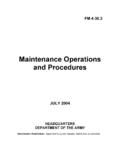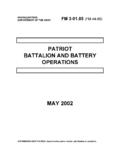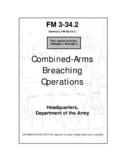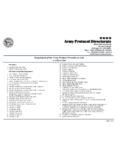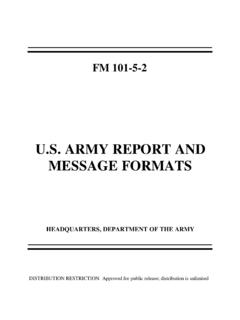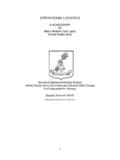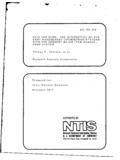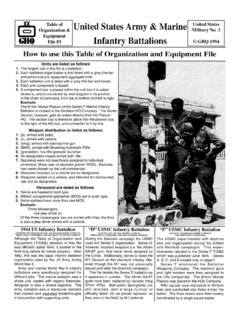Transcription of THEATER OFxOPERATIONS - BITS
1 FM 55-1 c V: % FIELD MANUAL o, m- ^ Ufl army transportation SERVICES THEATER OFxOPERATIONS t \ ROO A1 h 0 HEADQUARTERS, DEPARTMENT OF THE army SEPTEMBER 1971 * A \ FM 55-1 r 'L m j- 5^ 'lUn} 30/ Iftij \ FOREWORD 1. This manual provides guidance for the establishment and operation of an assistant chief of staff (ACS), movements, staff section or a staff transportation section in various headquarters units. It promulgates transportation doctrine and organizational structure developed by the study, The'Administrative Support, THEATER army , 1965-70 (TASTA- 70). \ 2. The major changes resulting from TASTA-70 are as follows: a. Changes in organizational structure of transportation movement con- trol units and terminal, railway, and motor transport headquarters units. b. Establishment of a transportation command headquarters for com- mand and supervision )>f units employed in the communications zone transportation service.
2 \ c. Establishment of a transportation composite group for command and supervision of transportation '^ervice in support of independent or separate division forces. 3. The manual also includes a short discussion of the THEATER army command organizational and terVitorial structure and includes as appen- dixes sample formats for a transportation plan, a transportation annex to an administrative/logistic order,\and a standing operating procedure for an ACS, movements, or a transportation staff section. 4. Chapter 3 provides personal type\guidance to the ACS, movements, or staff transportation officer to assist him in performing his staff functions. 5. Chapter 4 through 9 discuss capabilities and major task equipment of transportation units. \ \ \ V + FIELD MANUAL *FM 55-1 HEADQUARTERS DEPARTMENT OF THE army WASHINGTON, , 2 September 1971 No.
3 55-1 CHAPTER 1. Section I. II. CHAPTER 2. Section I. II. III. IV. CHAPTER 3. Section I. II. III. IV. V. CHAPTER 4. Section I. II. III. IV. CHAPTER 6. 6. 7. 8. 9. 10. APPENDIX A. B. C. Index army transportation SERVICES IN A THEATER OF OPERATIONS Paragraph Page INTRODUCTION (STANAG 2079) General 1-1 1-8 1-1 THEATER army Command Structure 1^4 1-9 1-2 THEATER army transportation SERVICES (STANAG S 2084 AND 2117) General 2-1 2-8 2-1 transportation Composite Headquarters Units 2-4 2-8 2-8 transportation Management Services and Mode Operations 2-9 2-18 2-18 International Standardization Agreements 2-14 2-15 2-16 transportation STAFF DUTIES, FUNCTIONS, AND LOCATIONS (SOLOG s 27R AND 31R) General 8-1 8-8 8-1 Staff transportation Functions and Responsibilities 8-4 8-6 8-8 Location of Assistant Chief of Staff, Movements, and transportation Staff Sections 3-7 3-14 8-6 Principles of Movements ( transportation )
4 3-15 8-19 8-6 transportation Planning 3-20 8-27 8-7 transportation SERVICE MOVEMENTS MANAGEMENT AND HIGH- WAY REGULATION (STANAG S 2025, 2041, 2151, 2154, 2155 2156, 2159, 2164; SOLOG S 27R, 31R, 50R) Introduction 4-1 4-2 4-1 Movement Control Units 4-8 4-6 4-8 Movement Control Center Operations 4-7 4-12 4-6 Highway Regulation 4-13 4-17 4-10 MOTOR TRANSPORT SERVICE 5_1_5_16 6-1 RAIL TRANSPORT SERVICE 6-1 6-9 6-1 AIR TRANSPORT SERVICE 7-1 7-5 7-1 WATER TRANSPORT SERVICE 8-1 8-8 8-1 TERMINAL SERVICES 9-1 9-8 9-1 SUPPORT OF transportation SERVICES 10-1 10-10 10-1 REFERENCES A-l A-7 A-l INDEX OF transportation -RELATED INTERNATIONAL STANDARD- IZATION AGREEMENTS B-l SAMPLE transportation PLAN AND ANNEX AND OUTLINE FOR PREPARING A STANDING OPERATING PROCEDURE FOR AN ASSIS- TANT CHIEF OF STAFF, MOVEMENTS, AND A transportation STAFF SECTION C-l, C-2 C-l Index-1 -0.
5 / ^ *Thi> manual uperaede FM 55- , 29 September 1961; FM 55-6-1 (Tnt), 14 April 1967; and FM 55-9, 21 Juna 1965. Ill FM 55-1 CHAPTER 1 INTRODUCTION (STANAG 2079) Section I. GENERAL 1-1. Purpose and Scope a. This manual provides a general guide for and is a handbook to assist the assistant chief of staff, movements, and staff transportation of- ficers at all levels of command in familiarizing themselves with their duties and functions and with principles of transportation , mode-of-trans- port organizations and operations, movements management, and transportation terminal opera- tions. The manual also presents a brief discus- sion of the THEATER army , the THEATER army sup- port command (TASCOM), and the field army support command (FASCOM). b. The manual discusses the organization and functions of three major transportation head- quarters units that command varied type trans- portation units: the headquarters and headquar- ters company, transportation command (TOE 55-2), employed in the communications zone; the headquarters and headquarters company, trans- portation brigade (TOE 55-62), employed in FASCOM and in a corps support command (CO- SCOM) ; and the headquarters and headquarters company, transportation composite group (TOE 55-52), employed in support of independent divi- sion operations.
6 C. For commanders and staffs at all levels, this manual provides requirements for and a guide to the establishment of staff transporta- tion sections within their organizations and thea- ter transportation services. d. International agreements (SOLOG s, STA- NAG s, SEATO s, etc.) that apply to transporta- tion services in a THEATER of operations are dis- cussed in paragraphs 2-14 and 2-15. e. This manual is applicable to (1) General war, to include consideration of employment of and protection from nuclear and chemical weapons and protection from enemy use of biological agents or weapons. (2) Limited war. (3) Cold war, to include stability operations. 1 2. Review Components Users of this manual are encouraged to submit recommended changes and comments to improve the publication. This manual combines transpor- tation doctrine with procedural data.
7 Readers or reviewers should key their comments to the spe- cific page, paragraph, and line of the text in which the change or addition is recommended. Reasons will be provided for each comment to assure un- derstanding and complete evaluation by the pro- ponent agency. Comments should be submitted on DA Form 2028 (Recommended Changes to Pub- lications) and forwarded direct to the Command- ing Officer, US army Combat Developments Com- mand transportation Agency, Fort Eustis, Vir- ginia 23604. Comments will be accepted in let- ter format if DA Form 2028 is not available. Originators of proposed changes or additions to the manual that may constitute a significant modification of approved army doctrine may send an information copy through command channels to the Commanding General, US army Combat Developments Command, Fort Belvoir, Virginia 22060, to facilitate review and followup.
8 1 3. Definition a. The assistant chief of staff (ACS), move- ments, is a general staff officer position in the headquarters of TASCOM, FASCOM, and the corps support brigade. This position, created in 1966 by the study, The Administrative Support, THEATER army , 1965-70 (TASTA-70), has the same functions as the former staff transportation officer. In fact, the terms assistant chief of staff, movements ; staff transportation officer ; transpor- 1-1 FM 55-1 tation staff officer; and transportation officer as used throughout this manual refer interchange- ably to a separate staff section for transportation functions assigned to a headquarters or subordi- nate to the G4 or director of services staff ele- ments. For a delineation of the functions of the ACS, movements, position, see chapter 3. b. Movements management refers to functions performed by staff transportation officers and transportation movement control units or teams of a command.
9 It encompasses planning, coordi- nating, programing, and monitoring the alloca- tion and use of available transportation resources in accomplishing the commander s movement re- quirements, to include highway regulation func- tions. FM 55-10, army transportation Move- ments Management, contains a detailed discussion of movements management. c. Movement control is the planning, routing, scheduling, and control of personnel and supply movements over lines of communication; also an organization responsible for these functions. d. Traffic management is the direction of func- tions incident to effective and economical pro- curement and use of passenger and freight (mili- tary and commercial) transportation services. e. Mode operations is a collective term used to indicate operations of one or more transport modes (highway, rail, water, and air) within the THEATER of operations.
10 /. Terminal operations include command and control of army operations at water terminals (established ports, beaches, and inland water- ways), air terminals (Air Force and army ), in-transit areas, and mode or means transfer points. g. Throughput is the shipment of supplies from points of origin (normally terminals or depots) as far forward into the combat zone as possible, bypassing one or more intermediate supply acti- vities. Rehandling and transshipment (transfer- ring) at intermediate locations within the trans- portation system are avoided whenever possible. This system of distribution tends to make such facilities as ports, beaches, depots, and transfer points less lucrative targets for nuclear attack. h. Inventory in motion is a term used to iden- tify a revitalized and integrated supply and trans- portation management concept which has as its ultimate goal nonstop supply support direct from the continental United States (CONUS) to the direct support level.



